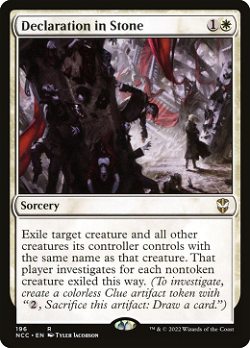About Declaration in Stone
Declaration in Stone, Sorcery, designed by Tyler Jacobson first released in May, 2020 in the set Shadows over Innistrad Promos and was printed exactly in 5 different ways.
Declaration in Stone is a powerful card that can be beneficial in a white-based control deck looking to deal with threats efficiently. While it can provide card advantage through investigating, there are potentially better options like Path to Exile or Swords to Plowshares that offer more immediate removal at the cost of not exiling all creatures with the same name. However, Declaration in Stone can still find a place in decks that value the investigative aspect or need a mass removal option against token strategies.


— Comments 0
, Reactions 1
Be the first to comment